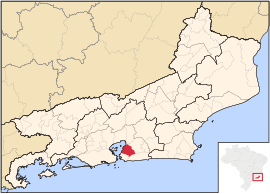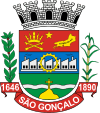São Gonçalo, Rio de Janeiro facts for kids
Quick facts for kids
São Gonçalo
|
|||
|---|---|---|---|
|
Municipality
|
|||
| Município do São Gonçalo Municipality of São Gonçalo |
|||
|
|||
| Nickname(s):
Manchester Fluminense
|
|||

Localization in Rio de Janeiro
|
|||
| Country | |||
| Region | Southeast | ||
| State | |||
| City Established | September 22, 1890 | ||
| Government | |||
| • Type | Mayor-council | ||
| • Body | Prefeitura da Cidade do Rio de Janeiro | ||
| Area | |||
| • Total | 249.142 km2 (96.194 sq mi) | ||
| Elevation | 19 m (62 ft) | ||
| Population
(2012)
|
|||
| • Total | 1,016,128 | ||
| • Density | 4,078.51/km2 (10,563.3/sq mi) | ||
| Demonym(s) | goncalense | ||
| Time zone | UTC−3 (BRT) | ||
| • Summer (DST) | UTC−2 (BRST) | ||
| Area code(s) | +55 21 | ||
São Gonçalo is a large city in the state of Rio de Janeiro, Brazil. As of 2012, about 1,016,128 people live there. This makes it the second most populated city in the state, right after the capital city, Rio de Janeiro. The city covers an area of about 249 square kilometers (96 square miles).
Contents
Exploring São Gonçalo
São Gonçalo is an important city in Brazil. It is known for its large population and its location in the beautiful state of Rio de Janeiro.
What is the Climate Like?
São Gonçalo has a tropical Atlantic climate. This means it has rainy summers and winters that are usually drier. Temperatures can change a lot throughout the year.
In summer, it can get very hot, sometimes up to 40°C (104°F). During winter, it can cool down to about 10°C (50°F). Most of the time, the temperature stays between 25°C and 35°C (77°F to 95°F) for highs, and 14°C to 24°C (57°F to 75°F) for lows. From May to October, the weather is often milder because it's drier and less hot.
Who Lives in São Gonçalo?
São Gonçalo has been growing quickly in terms of its population. In 2012, over 1 million people lived in the city. This was a big jump from 960,631 people in 2007.
The people living in São Gonçalo come from different backgrounds. According to the 2012 census, about 22.7% of the people were White, 54.1% were Brown, and 20.2% were Black or African. A small number of people were from two or more races (3%) or Asian (0.02%).
People from Other Countries
About 3.5% of the people in São Gonçalo were not from Brazil. This is a higher number compared to many other cities in Brazil. Most of these non-Brazilians were from Paraguay (2%), Bolivia (1%), and China (0.5%).
Life in the City
The 2012 census also showed that some people in São Gonçalo faced challenges with poverty. About 31.5% of the population was officially living in poverty in 2012. This was a big improvement from 1990, when 81% of the population was in poverty. Only a small part of the population, about 4.7%, was considered "Class A" (meaning they had higher incomes).
Learning and Health
São Gonçalo has important places for education and healthcare.
Education Opportunities
One of the most important schools in the city is the Rio de Janeiro State Teachers' Training College (FFP-UERJ). It is the biggest college for training teachers in the entire state of Rio de Janeiro. Most of its students live in São Gonçalo, but many also come from nearby cities like Niterói, Rio de Janeiro, and Itaboraí.
Hospitals and Healthcare
The city has several hospitals to care for its residents. These include Hospital Estadual Alberto Torres, Eye Hospital Niteroi, Hospital Luiz Palmier, and Hospital Santa Maria, among others.
Challenges with Garbage Collection
Sometimes, São Gonçalo has problems with garbage collection. This can lead to trash building up on the streets. For example, in December 2008, waste collectors went on strike, which made the problem worse. In January 2011, garbage collection stopped for over a week in some parts of the city.
Famous People from São Gonçalo
São Gonçalo is the birthplace of Zélio Fernandino de Moraes. He was the founder of the Umbanda Branca religious sect, which is a spiritual group.
Images for kids
See also
 In Spanish: São Gonçalo (Río de Janeiro) para niños
In Spanish: São Gonçalo (Río de Janeiro) para niños






